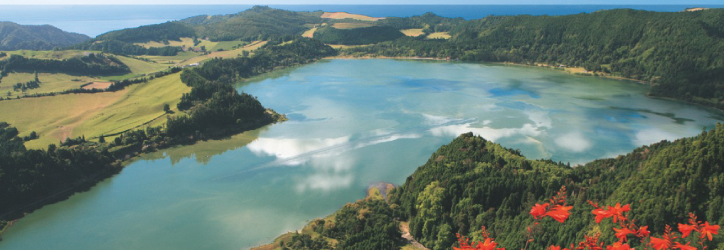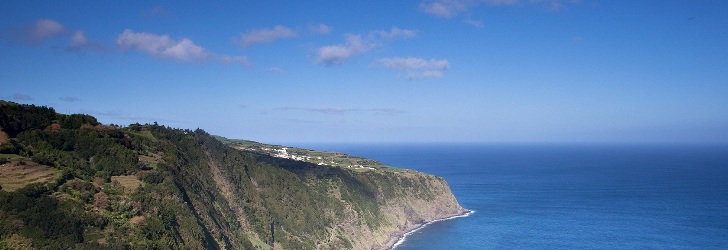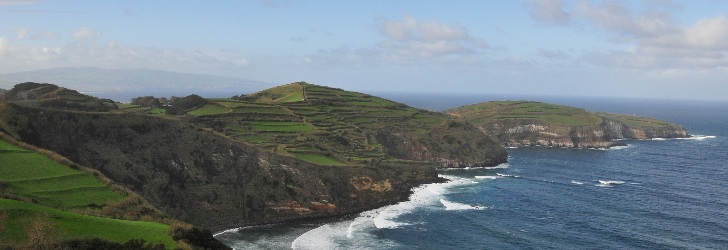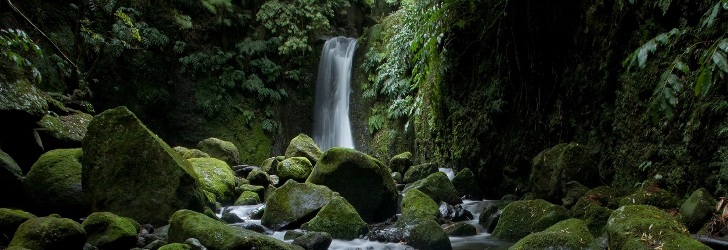[su_tabs]
[su_tab title=”Overview” disabled=”no” anchor=”” url=”” target=”blank” class=””]
GEOGRAPHY
São Miguel is the biggest island of the archipelago, with 62.1 km in length and 15.8 km at its maximum width. More than half of the Azorean population (137.856 inhabitants in 2011) occupies an area of 744.7 sq. km. Together with Santa Maria, located 81 km away, São Miguel is part of the Eastern Group of the Azores Archipelago. With an altitude of 1,105 m, Pico da Vara is the island’s highest point located at 37°48’34’’ latitude north and 25°12’40’’ longitude west.
HISTORY
Sometime between 1427 and 1431, the Portuguese navigators discovered the island of São Miguel, right after the island of Santa Maria. The initial settlement, dating from 1440 with the arrival of Gonçalo Velho Cabral, was carried out by people who came from the Portuguese regions of Estremadura, Algarve and Alentejo. Later, other communities made up of Moors, Jews and foreigners, namely French, also settled on the island. The fertile soils and the existence of some safe bays quickly transformed the island into a trading post. The economic growth was sustained mainly by the production and export of wheat and woad which boosted the island’s settlement.
Until the devastation left by the earthquake of 1522, the capital of the island was the town of Vila Franca do Campo. Then, Ponta Delgada started to play the most important role and became the capital in 1546. The end of the 16th century was marked by the attacks of privateers, and São Miguel was occupied by the Spanish army in 1582 during the Azorean resistance to the military forces of the new King of Portugal, Filipe II of Spain. After the Restoration of the Portuguese throne in 1640, the commercial development was given a new life by its connection with Brazil.
Throughout the 18th century and mid 19th century, the export of oranges, mainly to Great Britain, became the main source of wealth. Most churches, decorated with rich woodcarvings, and manor houses, built with refined stoneworks that are the delight of visitors, date from this period. From 1870 onwards, the orange groves were attacked by infectious diseases, and given the drastic reduction in production, many locals emigrated to Brazil and to the United States.
The introduction of new cultures – pineapple, tea, tobacco, hemp– contributed to the economic development of the 19th century following the turbulent Liberal Wars. The economy of the island kept growing during the 20th century given the expansion of agriculture and cattle breeding, which supplied part of the dairy industry. However, since the 1980s, the progress of the services sector has been increasingly noticeable, and it now employs most of the local population. Part of this sector, tourism is the latest investment of São Miguel, the island where the seat of the Regional Government of the Azores is located.

[/su_tab]
[su_tab title=”Nature” disabled=”no” anchor=”” url=”” target=”blank” class=””]
THE GREEN ISLAND
The landscape of São Miguel is marked by two mountain areas separated by a low altitude platform. Nicknamed the Green Island, its landscape is made up of extensive fields and patches of tress that were forced into the valleys of streams and into difficult to reach areas. Cryptomeria stands out on the island’s productive forest land and reaches large dimensions in dense woods that are one of the most iconic images of São Miguel. The original flora still survives in small areas, with native and endemic species such as the Azores heather, faya, laurel and holly serving as a shelter for a very special bird, the Azores Bullfinch, and making up a palette of different shades of green spread out along the horizon.
VOLCANIC LANDSCAPE
São Miguel is a land of lakes nested in volcanic craters that are many kilometres wide. The most iconic one lies in Sete Cidades. This is a place filled with legends and myths, and it deserves to be seen from the Vista do Rei Lookout; from there, in noble contemplation, one can see two twin lakes, the Green and the Blue, paired together by a bridge. The ecstasy moves on to Lagoa do Fogo (Fire Lake), which has a wilder nature. A large lake surrounded by extravagant, lush vegetation stands out in the Furnas Valley , which lives up to its nickname of Vale Formoso (Beautiful Valley). But the number of lakes does not stop here, since others can be found both in the Serra Devassa and in the central part of the island, including the Canário, Santiago, Éguas and Congro Lakes… There will always certainly be another lake waiting to be discovered.
Rows of small volcanic cones and stretches of undulating green land abruptly come to an end in the blue of the sea. The lookouts of São Miguel are mostly filled with this type of view. Sometimes, one can see islets along the coast. Such is the case of the magnificent Vila Islet in front of Vila Franca do Campo or of the Mosteiros Islet, glorious at sunset even when it is seen from the distant Ponta do Escalvado. In Nordeste, with its exuberant vegetation, the lookouts are surrounded by gardens and equipped for barbeques whilst one enjoys the exceptional views. This is also the case of the Lomba do Cavaleiro Lookout, overlooking the whole caldera of Povoação and its seven slopes.
The natural hot water pools are one of the most attractive features that São Miguel has to offer. They have different formats. They are spectacular at Caldeira Velha, a fine stream of crystal clear water running thorough bright ochre trenches excavated in dark rock. They are majestic in the pool of the Terra Nostra Park, a lake of ferrous, brown water located in a luxuriant botanic garden. They are hidden at the Poça da Beija, a pool of crystal clear water and ferrous mud. They are quiet at the Caldeiras of Ribeira Grande, where the thermal building dating back to 1811 is surrounded by trees and fumaroles. They are effusive in the Furnas Valley , home of dozens of thermal springs, fumaroles and carbonated water which transform the valley into a Mecca in terms of spas and into a virtual bottling shop.
COASTLINE
High cliffs covered with green forests, black basalt headlands that penetrate the sea, promontories and sweet inlets, challenging fajãs [flat, low-lying strips of land on the coast], and numerous beaches with grey volcanic sand are some of the features of São Miguel’s coastline that deserve to be seen and visited with tranquillity.
On the southern coast, beaches such as Pópulo, Vinha da Areia and Ribeira Quente invite you for a swim and are sought after by many people. But if you prefer a more intimate contact with nature, the beaches of Amora, Viola, Lombo Gordo and Mosteiros among many others await you. Amid tips of black rock, sunbathing areas and crystal clear sea, one finds natural swimming pools and ponds in various places on the island; Capelas, Calhetas and Lagoa are just some of these sites. And at the Ponta da Ferraria, what icing on top of the cake, Mother Nature takes care of heating the seawater with volcanic hot springs, offering an Atlantic Thalassotherapy in a unique natural setting.
Between Povoação and Furnas, Nordeste and Água Retorta, and wherever the rugged terrain ends in towering coastal cliffs, there is an invitation to explore the trails that since times immemorial have connected the villages and houses located along the coastline.
[/su_tab]
[su_tab title=”Heritage” disabled=”no” anchor=”” url=”” target=”blank” class=””]
CULTURE
Prominent national individuals were born on São Miguel, like the poet Antero de Quental (1842-1891) and the politician and essayist Teófilo Braga, who was elected President of Portugal in 1915. The poet Natália Correia (1923-1993), who stood out for her cultural, civic and political intervention, wrote the lyrics of the Official Anthem of the Azores, singing “From a destiny attained by glory / we will pick more fruits and flowers /as such is the sacred aim /of the stars that crown the Azores.” As for paintings, the highlight goes to those of Domingos Rebelo (1891-1975), the painter of the famous painting called “The Emigrants.” Regarding sculptures, the works of Canto da Maya (1890-1981) are outstanding. The Carlos Machado Museum, located in the Convent of Santo André in Ponta Delgada, stores the best pieces related to the Azorean culture, and it has important collections related to art, regional ethnography, toys, sacred art and natural history. Definitely one of the things to see in Ponta Delgada.
ARCHITECTURE
Ponta Delgada, lying around a natural bay and identified by its three arches known as the Portas da Cidade, stands out for the large number of churches and other buildings. Among them, the baroque São Sebastião Church and the Todos os Santos Church stand out along this architectural tour.
In Ribeira Grande, the chromatic game thickens between white masonry and basalt and ignimbrite stonework. This contrast is visible in churches, such as the Nossa Senhora da Estrela Church, with a monumental staircase and a singular black bell tower. There are also the Oito Arcos Bridge and the iron balconies of manor houses.
The water mills remain as witnesses of the past and can be found in several places on the island. On the Ribeira dos Caldeirões, in the municipality of Nordeste, there is one that has been recovered and is surrounded by the natural beauty of the waterfall along the same stream.
HANDICRAFTS
The industries of ceramics and clay works have an ancestral tradition. In Vila Franca do Campo, clay is used in rustic pieces adapted to daily use. In Lagoa, ceramics are decorated with drawings mainly painted in blue. In Ribeira Grande, the tile panels are still painted by hand.
The dolls made with corn leaves, recreating the regional costumes, came from the agricultural tradition. The delicate flowers made from fish scales, used in miniature floral arrangements, came from the fishing industry.
[/su_tab]
[su_tab title=”Festivities” disabled=”no” anchor=”” url=”” target=”blank” class=””]
São Miguel Island has many interesting cultural activities that you can enjoy during your holidays. the Holy Ghost Festivals represent an Azorean religious tradition, which is celebrated on all the islands. They take place around chapels called Impérios (Empires) from May to September. Intrinsically linked to São Miguel, the age-old Festa do Senhor Santo Cristo dos Milagres (Lord Holy Christ of Miracles Festival) venerates the statue of Christ kept at the Esperança Chapel in Ponta Delgada. The festivities last for three days and take place around the fifth Sunday after Easter Sunday. The Romeiros (Pilgrims) of São Miguel are groups of men who walk the island on foot during Lent, praying and visiting churches and chapels dedicated to the Virgin Mary.
Starting in the parish of Ribeira Seca, municipality of Ribeira Grande, the Cavalhadas de São Pedro (Saint Peter’s Horse Riders) take place on 29 June and are a parade of horse riders dressed in colourful outfits – symbolising a king, knights, lancers, stewards and horn players or trumpeters, riding equally adorned horses. Carnival is lively enjoyed in Ponta Delgada. The Batalha das Limas (Water Battle) is a tradition that persists, with groups confronting each other on the streets of the city throwing at each other various types of “weapons” filled with water. The festive season also includes various gala balls with merry-makers dressed in evening suits. There are various carnival parades in different localities which attract many participants and enthusiasts.
Dancing and brass band concerts are frequent throughout the various parishes of the island, especially during the festivities in honour of each locality’s patron saint. New Year’s Eve attains a new dimension at the Portas do Mar in Ponta Delgada, with its marina and cruise-ship terminal providing a new stage for music shows and exhibitions, with restaurants and bars animating the evening in the city.
[/su_tab]
[su_tab title=”Food & Drinks” disabled=”no” anchor=”” url=”” target=”blank” class=””]
From the various cultures introduced in the Azores the highlight goes to tea. The plantations of Gorreana and Porto Formoso, appearing in the horizon as a sea of green leaves, are unique in the Europe. During visits to the museum-factories, one learns the history and evolution of the machinery, before a well deserved cup of Azorean tea.
In Furnas, the pots containing meat and vegetables for a typical boiled/steamed dish are put into a sac and buried in the geothermal soil. The food cooks for approximately five hours. Before tasting the singular taste of a dish made in the natural heat of the earth, it will be worth waiting to see the lifting of the pot, with strong arms pulling the ropes that had been attached to the heavy pots.
On São Miguel Island there is a tradition for cultivating exotic fruits such as pineapple, annona, guavas and passion fruit, which are eaten raw or used to make liqueurs. The pineapple green houses, spread throughout Fajã de Baixo, Lagoa and Vila Franca do Campo, preserve age-old practices which can be discovered in a guided visit.
The cuisine of São Miguel is filled with fish dishes, always with a common factor: freshness. There are also various types of sea food, and delicacies like the barnacle, a crustacean boiled in sea water. The meat comes from the cattle bred in pastures, and it is soft and tasty. As for appetizers, there are the famous local red, mashed peppers served with fresh cheese. But these local red peppers are also used in various recipes. The bolo lêvedo from Furnas is a cake that is well known and may be served during any meal. As for sweets, the most famous are the Queijadas de Vila Franca do Campo (Vila Franca do Campo Custards). And to top another day in the vacation, smokers may even finish their meal with a locally manufactured cigar or cigarillo.
[/su_tab]
[/su_tabs]



